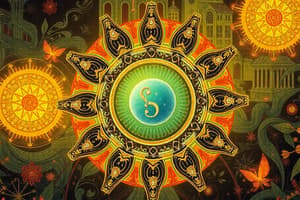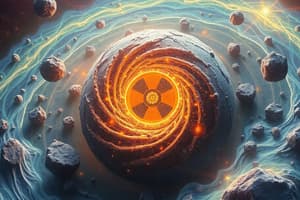Podcast
Questions and Answers
What is a nuclear fusion reaction?
What is a nuclear fusion reaction?
- A reaction where two light nuclei combine to form a heavier nucleus (correct)
- A reaction where a neutron is captured by a heavy nucleus
- A reaction involving the capture of an electron by a nucleus
- A reaction where a heavy nucleus splits into lighter nuclei
In a nuclear fission reaction, what happens?
In a nuclear fission reaction, what happens?
- A heavy nucleus absorbs a proton and becomes a lighter nucleus
- A heavy nucleus splits into two lighter nuclei (correct)
- A light nucleus captures a neutron and emits a photon
- Two light nuclei combine to form a single heavy nucleus
Which of the following is an application of radioactivity in medicine?
Which of the following is an application of radioactivity in medicine?
- Producing heat in nuclear reactors
- Generating electricity in power plants
- Detecting and treating tumors (correct)
- Studying chemical reaction mechanisms
How is the number of mass conserved in nuclear reactions?
How is the number of mass conserved in nuclear reactions?
What does the equation $^{235}U + ^1n \rightarrow ^{139}Xe + ^{95}Sr + 3 ^1n$ represent?
What does the equation $^{235}U + ^1n \rightarrow ^{139}Xe + ^{95}Sr + 3 ^1n$ represent?
Which of the following statements is true about the nuclear fusion reaction $^2H + ^3H \rightarrow ^4He + ^1n$?
Which of the following statements is true about the nuclear fusion reaction $^2H + ^3H \rightarrow ^4He + ^1n$?
What is the unit of measurement for the activity of a sample?
What is the unit of measurement for the activity of a sample?
Which device is used to measure the activity of a sample?
Which device is used to measure the activity of a sample?
What is the radioactivity level of uranium ore?
What is the radioactivity level of uranium ore?
How long is the half-life (t1/2) of Cesium-137?
How long is the half-life (t1/2) of Cesium-137?
What property does the half-life of a radioactive isotope affect?
What property does the half-life of a radioactive isotope affect?
Which application of radioactivity is used to diagnose cancers?
Which application of radioactivity is used to diagnose cancers?
What technique is used to determine the age of an ancient object by measuring its activity?
What technique is used to determine the age of an ancient object by measuring its activity?
Which radioactive element is used as a fuel in nuclear power plants?
Which radioactive element is used as a fuel in nuclear power plants?
Who discovered radioactivity in 1896?
Who discovered radioactivity in 1896?
What type of reactions result from nucleus instability?
What type of reactions result from nucleus instability?
What is emitted during the disintegration of a parent nucleus?
What is emitted during the disintegration of a parent nucleus?
How is the activity of a radioactive sample measured?
How is the activity of a radioactive sample measured?
What is an example of nuclear fission?
What is an example of nuclear fission?
What is the product of the fusion of $^2_1H$ and $^3_1H$?
What is the product of the fusion of $^2_1H$ and $^3_1H$?
Which application is NOT among those listed for radioactivity?
Which application is NOT among those listed for radioactivity?
Which particles cause ionizations when passing through living matter?
Which particles cause ionizations when passing through living matter?
What is the unit of measurement for the activity of a sample?
What is the unit of measurement for the activity of a sample?
Which process describes the exponential decrease of activity over time?
Which process describes the exponential decrease of activity over time?
What is the half-life of a radioactive isotope?
What is the half-life of a radioactive isotope?
Which of the following is a medical application of radioactivity?
Which of the following is a medical application of radioactivity?
Which element is mentioned as a fuel in nuclear power plants?
Which element is mentioned as a fuel in nuclear power plants?
What term is used for applying radioactivity to determine the age of ancient objects?
What term is used for applying radioactivity to determine the age of ancient objects?
What type of particle is emitted during alpha decay?
What type of particle is emitted during alpha decay?
What material can stop beta particles?
What material can stop beta particles?
What happens during a beta-minus ($\beta^-$) decay?
What happens during a beta-minus ($\beta^-$) decay?
Which type of radiation is the most penetrating?
Which type of radiation is the most penetrating?
What does the gamma radiation emitted by atoms consist of?
What does the gamma radiation emitted by atoms consist of?
What are the laws of conservation during a nuclear reaction?
What are the laws of conservation during a nuclear reaction?
Where are stable nuclides located on the Segre diagram?
Where are stable nuclides located on the Segre diagram?
What is the symbol for the alpha particle?
What is the symbol for the alpha particle?
What is the result when a neutron strikes a ${}^{235}U$ nucleus?
What is the result when a neutron strikes a ${}^{235}U$ nucleus?
Which smaller nuclei can be produced from the fission of ${}^{235}U$?
Which smaller nuclei can be produced from the fission of ${}^{235}U$?
What is a chain reaction in the context of nuclear fission?
What is a chain reaction in the context of nuclear fission?
What is one application of fission reactions?
What is one application of fission reactions?
Which element is commonly used as a fuel in fission reactions?
Which element is commonly used as a fuel in fission reactions?
What does the symbol A represent in a nucleus?
What does the symbol A represent in a nucleus?
What is the charge of a single proton?
What is the charge of a single proton?
How can isotopes be characterized?
How can isotopes be characterized?
What ensures the cohesion of the nucleus against electrical repulsive forces?
What ensures the cohesion of the nucleus against electrical repulsive forces?
What usually accompanies the decay of a radioactive nucleus?
What usually accompanies the decay of a radioactive nucleus?
Which type of radioactive particle consists of two protons and two neutrons?
Which type of radioactive particle consists of two protons and two neutrons?
Which type of radioactivity is the most penetrating?
Which type of radioactivity is the most penetrating?
Which statement about radioactive decay is true?
Which statement about radioactive decay is true?
What results from the transformation of a neutron into a proton?
What results from the transformation of a neutron into a proton?
What differentiates natural radioactivity from artificial radioactivity?
What differentiates natural radioactivity from artificial radioactivity?
Flashcards are hidden until you start studying
Study Notes
Structure of an Atomic Nucleus
- A nucleus is represented by the symbol X, where X is the chemical symbol of the element.
- A nucleus consists of protons, neutrons, and electrons.
- The number of protons (Z) is equal to the atomic number, which determines the element of an atom.
- The number of neutrons (N) is equal to the mass number (A) minus the atomic number (Z).
Isotopes
- Two nuclei are isotopes if they have the same number of protons (Z) but a different number of neutrons (N).
- Isotopes have the same atomic number but different mass numbers.
Stability and Instability of Nuclei
- Forces within a nucleus:
- Electromagnetic repulsive forces between protons.
- Strong nuclear forces between nucleons (protons and neutrons).
- Some nuclei are stable, while others are unstable and can undergo radioactive decay.
- The stability of a nucleus depends on the number and type of nucleons it contains.
Radioactivity
- Radioactivity is a process in which unstable nuclei emit radiation to become stable.
- Radioactive decay involves the emission of alpha, beta, or gamma radiation.
- Alpha particles are composed of two protons and two neutrons.
- Beta particles are high-energy electrons emitted from the nucleus.
- Gamma radiation is high-energy electromagnetic radiation.
- Radioactivity is a natural process, but it can also be induced artificially.
Different Types of Radioactivity
- Alpha decay: emission of an alpha particle from the nucleus.
- Beta decay: emission of a beta particle from the nucleus.
- Gamma decay: emission of gamma radiation from the nucleus.
Laws of Conservation
- During a nuclear reaction, the number of protons and neutrons is conserved.
- The total number of protons and neutrons before the reaction is equal to the total number of protons and neutrons after the reaction.
Nuclear Reactions
- Spontaneous nuclear reactions: radioactive decay.
- Induced nuclear reactions: fission and fusion reactions.
- Fission: a heavy nucleus splits into two or more lighter nuclei.
- Fusion: two or more light nuclei combine to form a heavier nucleus.
Applications of Radioactivity
- Medical applications: diagnostic techniques (scintigraphy and tomography), cancer treatment (radiotherapy).
- Scientific applications: exploration of the Earth and its history.
- Energy production: nuclear power plants.
Dangers of Radioactivity
- Ionizing radiation can cause harm to living organisms.
- Radioactive materials can contaminate the environment and pose health risks.
- Exposure to radiation can increase the risk of cancer and other health problems.
Studying That Suits You
Use AI to generate personalized quizzes and flashcards to suit your learning preferences.




